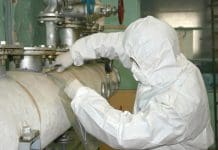New guidance has been published on how to manage the possible health risks associated with nanomaterials in construction. It follows research sponsored by the Institution of Occupational Safety and Health (IOSH) into how widespread their use is and the risks they might create. Professor Alistair Gibb and Dr Wendy Jones from Loughborough University, who led the research, look at the issues
The use of nanomaterials in construction is becoming increasingly common – and it is easy to see why.
They have brought about new construction products with incredibly innovative properties. Self-cleaning glass – as reportedly used on the roof of St Pancras train station in London – is one example, with others being super-efficient insulation and very high-strength concrete.
It is estimated that by 2025, half of our building materials may contain nanomaterials, enabled by technological advances that have allowed for the manipulation of matter at an atomic level.
But do we need to stop for a moment and consider whether they may introduce additional health risks? If so, how might we successfully manage such risks? Recently published research, conducted at Loughborough University and sponsored by the Institution of Occupational Safety & Health (IOSH), examined how nanomaterials are being used in construction and what health risks might be associated with them. From this, we produced guidance for industry on how these risks can be assessed and managed.
Research
Our team found that nanomaterials are primarily used in surface coatings, concrete, window glass, insulation and steel.
As long as they are embedded in a solid, stable structure, there is no risk. However, when workers are exposed to nanoparticles or nanofibres in the form of dusts or aerosols – which can occur during construction or demolition – then there may be a risk. There are many factors that contribute to the toxicity of nanomaterials. Size is one, as smaller particles are typically more reactive than larger ones. Other factors include: what the substance is, in terms of its chemical composition and type and structure; how soluble it is and whether the particles stick together; whether other substances or contaminants are present; and the shape of the particle.
The final point here is of particular importance. We know, for example, that some fibres might behave like asbestos and become lodged in the lungs. Those which are long, straight and stiff, such as certain Carbon Nanotubes (CNTs), are the most likely to be problematic. However, many other CNTs are shorter or curly and these are much less likely to be hazardous.
What was clear from our study is that our knowledge of the risks of nanotechnology is far from complete. The evidence around the harmfulness of particular nanoparticles is limited. Even more problematically, we have relatively little information on which nanomaterials are being used in construction materials. For example, CNTs are seemingly contained in only a handful of specialist products; but we lack information as to what the shape of those particular CNTs might be (over 50,000 different ones are believed to exist).
Much more in-depth research is required to provide clear evidence of the likelihood of workers on construction and demolition project being exposed to particles, what those particles might be and whether there are significant associated health risks.
Guidance
With so many unanswered questions, pending further research into the subject, it is not easy to say what companies need to do to ensure employees are not at risk from nanomaterials. However, it is important to remember there are many existing risks in construction and demolition that we already know about.
For example, the presence of respirable crystalline silica (one of the carcinogens targeted by IOSH’s No Time to Lose campaign) is a major existing risk. Organisations are advised to continue to concentrate on managing these existing risks as nano-enabled products currently in common use are not believed to increase hazard levels to a great extent.
Also, controls such as extraction and dust suppression used for existing risks can negate the additional risk from most nanomaterials, as can the use of personal protective equipment; though this should only be used when control is not possible with other means, or in addition to other control measures.
On top of that, companies should be asking questions of the suppliers of new materials, including what shape and size the particles in a product are. Information about the presence of nanomaterials should be recorded, for example in the CDM health and safety file or in BIM. This will support decision making about building changes or demolition in future when additional information on toxicity might be available.
Where to get assistance
The rise of nanomaterial use will undoubtedly continue. However, this should not be at the expense of people’s health. It is vital, therefore, that in addition to reminding construction employers of the importance of good practice in health risk management generally, this study and guidance is the springboard to greater research.
To view the full report and guidance, visit www.iosh.co.uk/nanotechnology.
For more information about IOSH, visit www.iosh.com.
Professor Alistair Gibb
Professor of Construction Engineering Management
Loughborough University School of Architecture,
Building & Civil Engineering
Tel: +44 (0)1509 223097
www.lboro.ac.uk/departments/abce/staff/alistair-gibb/
Dr Wendy Jones
Research Associate
Loughborough University School of Architecture,
Building & Civil Engineering
Tel: +44 (0)1509 226196
www.lboro.ac.uk/departments/abce/staff/wendy-jones/






![[VIDEO]What to expect when you’re inspecting: Using DorTrak for fire door inspections](https://www.pbctoday.co.uk/news/wp-content/uploads/2025/02/maxresdefault-218x150.jpg)






